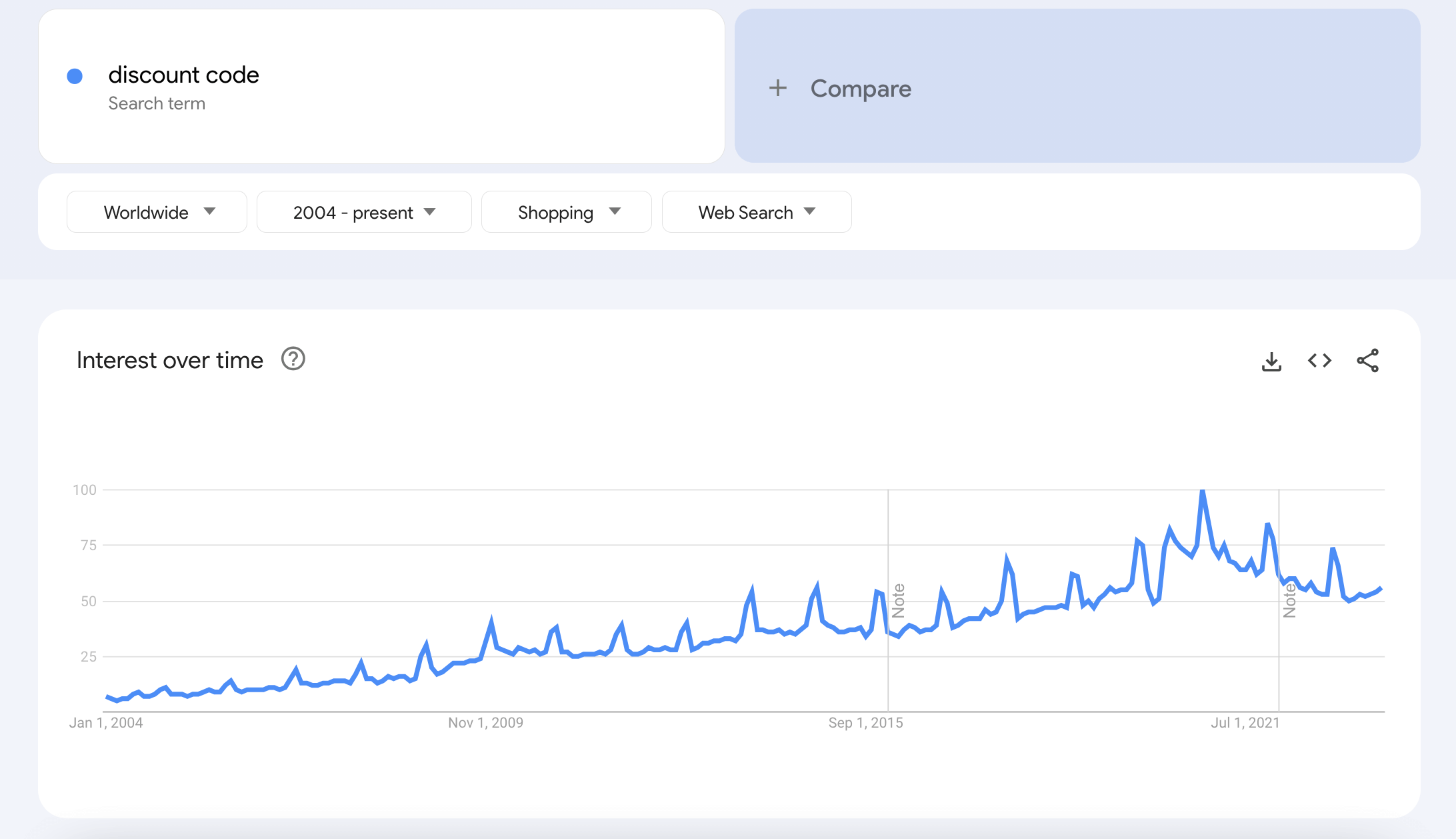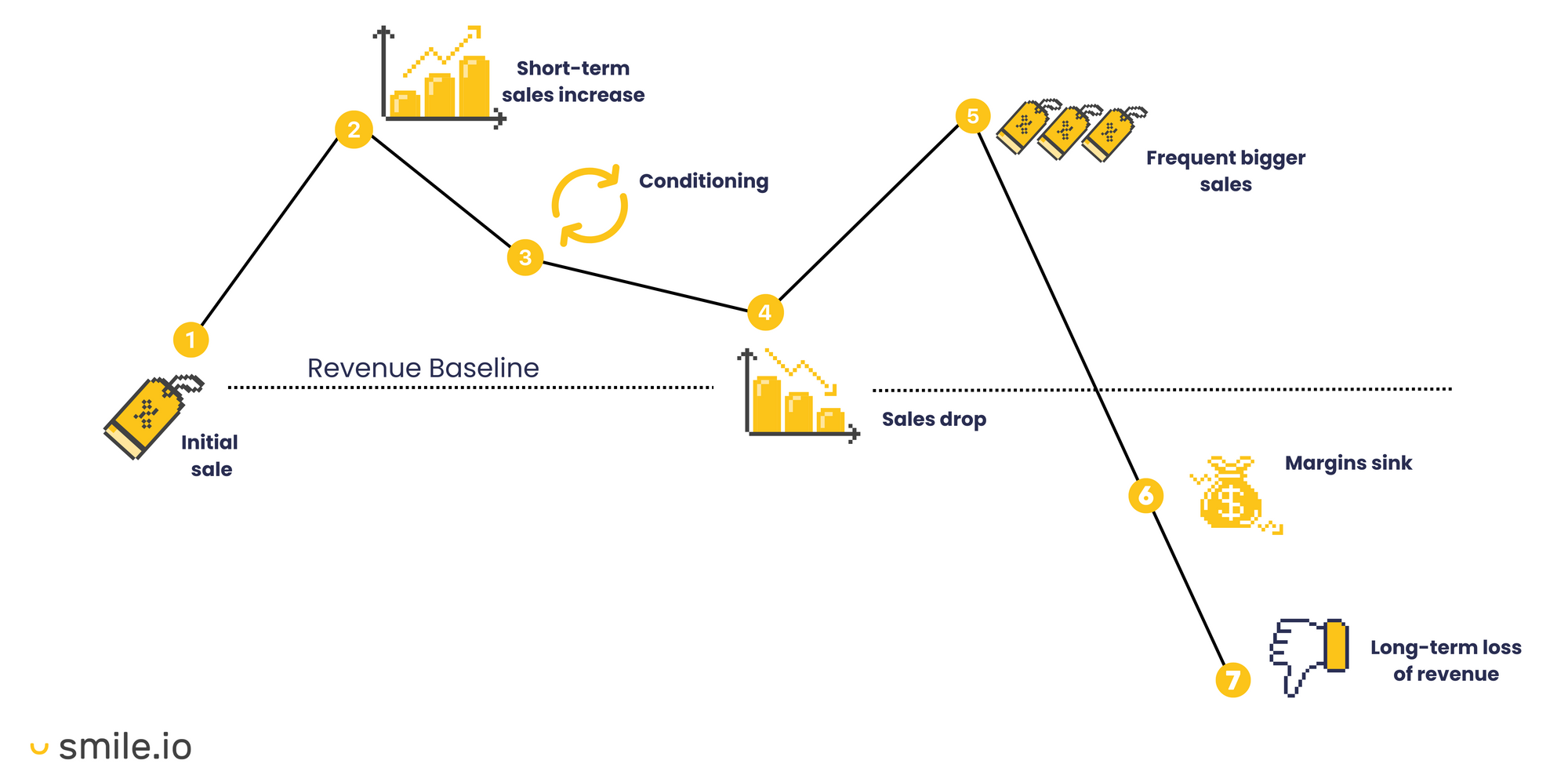Discounts seem like a good business strategy, right? Well, it depends on how often you run discounts. Ever since Google first started tracking search results in 2004, the number of searches made for terms like “discount code,” “coupon,” and “online sale” have been steadily increasing, showing that from the time people started shopping online customers have been trying to get the most out of every dollar they spend. In fact, 70% of people have reported opening brand emails purely looking for coupons!

This behavior has led merchants into a discounting frenzy to attract sales, but at what cost? At a glance, this might not seem like such a bad idea. Unfortunately, the reality of discounting can be far more sinister, as the perpetual race to the bottom has proven to be an absolutely disastrous long-term business model.
Discounting 101: the death spiral

To understand the dangers of the discounting vortex, let’s look at each part of the cycle to uncover the consequences of always giving out discounts.
Stage 1: the initial sale
The first stage of the discounting spiral is the first discount sale you run. This can be good for your store because it attracts new customers who might not have had any reason to try your products in the past. More people visiting your store means more opportunities for conversion and a greater chance to have more customers join your brand community.
Of course, your customers also benefit. Whether they’re new or returning, this sale lets shoppers purchase your products at a discounted rate, and they are left with an exceptional customer experience that colors your brand in a positive light.
Stage 2: short term sales increase
After your first discount sale, your store’s revenue is going to experience a quick burst of growth. This growth is not only good for you as a merchant but also for the customer — the more revenue you make, the more likely you are to reward them for doing business with you by holding another discount sale in the future.
Stage 3: conditioning
Unfortunately, that initial discounting has lasting negative consequences. Now that customers have been introduced to your products at a much lower price point, they are being conditioned to expect discounts with every purchase. Or worse, the customers you acquired through that first sale will not shop with you until they see the same or even greater discount they previously saw on your site.
Rather than seeing your brand as more valuable it actually seems less valuable, since shoppers start to only buy products at the discounted rate. This discounting mentality mainly attracts deal hunters who won’t see the value of your brand, and checkout as guests instead of creating an account. Similarly, your community members begin to question the value of staying engaged, resulting in fewer regular repeat purchases that drive a large portion of your revenue.
Stage 4: sales drop
Once customers discover that discounts have stopped, your sales will dip as they take their business elsewhere. No matter how much they like your products, your committed community members will also start to feel alienated, if they have been conditioned to expect frequent discount offers. This can cause them to lose trust in your brand and damage the relationship you’ve built with them. Whether it’s true or not, they will start to leave your brand for greener pastures.
Stage 5: frequent, bigger sales
At this point, panic begins to sink in as you realize you need to act fast. In your desperation, you begin to offer more frequent, bigger sales that take your discounting game to a whole other level. Just like before, your sales will begin to incrementally creep upwards, offering you false hope that this trend can continue.
These additional sales will help soothe your community members that stuck around, too. Since they’re also able to take advantage of all these discounts, they’re able to get more with each purchase— all while earning rewards without having to increase their spending amount. No matter how you slice it, customers are reaping huge benefits from big discounts that create zero value for your business. In the end, frequent, bigger discounts lead to a cut in your profit margins.
Stage 6: margins sink
Sooner than you think, you will have to acknowledge the havoc all of your discounting has caused. With so many customers buying more at significantly lower prices, you’ve been sacrificing more profit out-of-pocket in an effort to keep up with the increased (and heavily discounted) supply and demand.
No matter what your business looks like, the costs of continuous discounting aren’t affordable. Disenchanted customers with no true loyalty to your brand community will arrive looking for nothing but the cheapest option they can find, and your store will very quickly find itself in the red.
To add insult to injury, you will continue to bleed customers. With so many sales being offered at an increasing rate, your once dedicated community members will begin to grow suspicious as they begin to wonder why products are constantly on sale. Shoppers tend to assume products are discounted because they’re of poorer quality, out-of-date, or because a store is doing poorly.
Whatever assumption they choose to make, it’s severely damaging to your brand, threatens your customer relationships, and devalues your products exponentially.
Stage 7: long-term loss of revenue
Short-term wins can often cloud your best judgement and leave you open to harsh repercussions that are difficult (or even impossible) to recover from. Before you know it, the cycle of discounting you started will end up being a curse rather than a blessing when you have no customers and no revenue to show for it.
Practicing safe discounting (and what to do instead)
Despite the potential doom of discounting often, it can actually be part of an overall retention and acquisition strategy in ways that are still affordable for your business. Here are a few ways it can be done.
Tie benefits to profitable actions
While discounts often seem to be for the benefit of the customer, they can also work in your favor. Rewarding your customers with discounts for referring friends, providing product reviews, or sharing your products on social media are three examples of simple actions that not only boost trust in your brand but also attract new customers to your store with valuable social proof.
Offering an incentive for completing these actions shows customers the value of joining, engaging with, and sharing your brand community. When value is a two-way street it increases the likelihood that your customers will want to become members.

Free shipping
Free shipping is a major factor in delivering a great customer experience in ecommerce. It’s also a must for customers, or you risk a high percentage of abandoned carts. According to insights from JungleScout’s Consumer Trends Report, 80% of consumers expect free shipping when ordering a certain dollar amount of products, and 66% of customers expect free shipping for all online orders.
Free shipping is something that people value and are willing to switch brands for. It provides a decrease in the total purchase price that new customers are looking for without taking away from the value of your products.
This is one of the oldest discounts in the book but still packs a powerful punch. Even ecommerce giants like Amazon use this discounting strategy but with a twist—loyalty program membership. By requiring customers to be a part of its loyalty program, Amazon Prime, to redeem free shipping rewards, Amazon fosters profitable shopping behaviors. You can do the same by offering free shipping as a reward in your loyalty program or simply by placing a minimum purchase amount threshold. This will increase your average order value, and reward your loyal community members at the same time.
Free gifts
Presenting free products as a gift immediately makes it way more valuable to your customers. After all, who doesn’t like receiving gifts? It makes your customers feel special and appreciated no matter what the product is, and adds value to the transaction as opposed to subtracting in order to create value. You can set up free gift rewards with thresholds just like free shipping, making this a double-duty discounting strategy—customers have to spend more to get more.
Using your rewards program as an event-based marketing tool
In order to create a loyalty loop and engage customers to come back again and again, brands have gotten creative with their loyalty and rewards programs. Brands are using their rewards program as an event-based marketing tool, tying exclusive points to certain products, offering a product as a reward that can’t be purchased (like free gifts), or running special campaigns that allow customers to earn double the points during select timeframes.
Running bonus points campaigns
One way to lock in customers for repeat purchases is through bonus points events and redemption campaigns. Put simply, you offer customers the chance to earn double the points during a specific timeframe. For example, you can offer 2x the points on all purchases for a single weekend or your brand's birthday. Customers are incentivized to shop and earn more points, maximizing their reward balance, which can be spent on a second purchase. Using this as an event-based marketing strategy is great for brands that can not offer large discounts. It’s also a great way to get shoppers in during slow seasons for retail.

Reward programs make discounting valuable instead of deadly
The best part about each of these discounting methods is that they can all be easily managed with the use of a rewards program. With the right tool, you can offer rewards that impact your long-term revenue by using them to foster a brand community built on loyal and repeat customers that enable sustainable growth.
A rewards program also gives you the option of using points as a purchase incentive. By issuing points to your community members, you’re able to elevate every single purchase and give them the opportunity to redeem them for the rewards that they find valuable. These rewards can be transactional or experiential, expanding your brand’s breadth of value and reaffirming your customers’ decisions to continue to shop with you.
If you use discounting strategies intelligently, you can turn a short-term win into a long-term victory by ensuring that both you and your customers are benefitting every time.
Remember—value can be a two-way street! Don’t find yourself in a discounting dead end.
Editor’s Note: This post was originally published on July 9, 2019, and was updated for accuracy and comprehensiveness on August 14, 2023.









